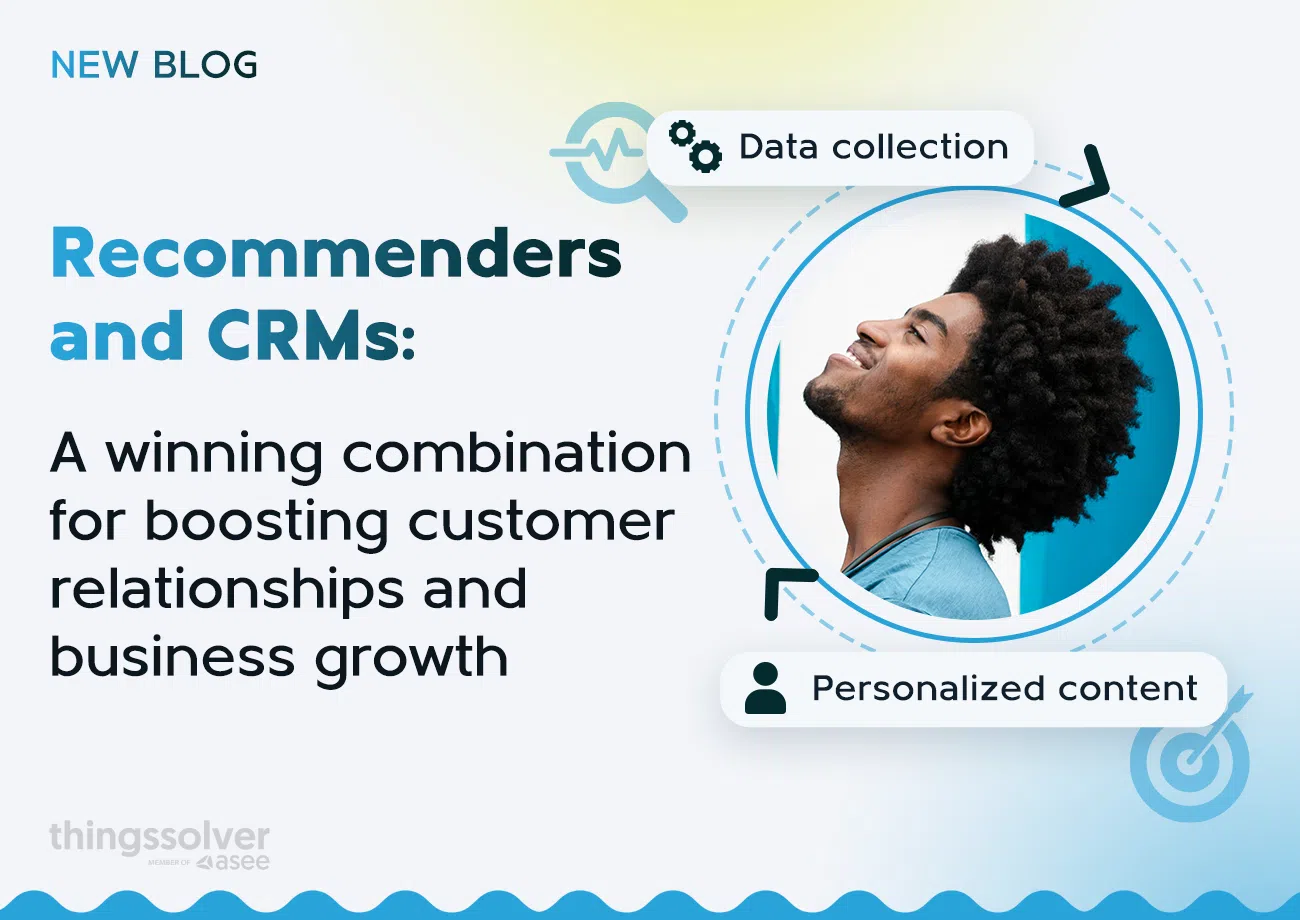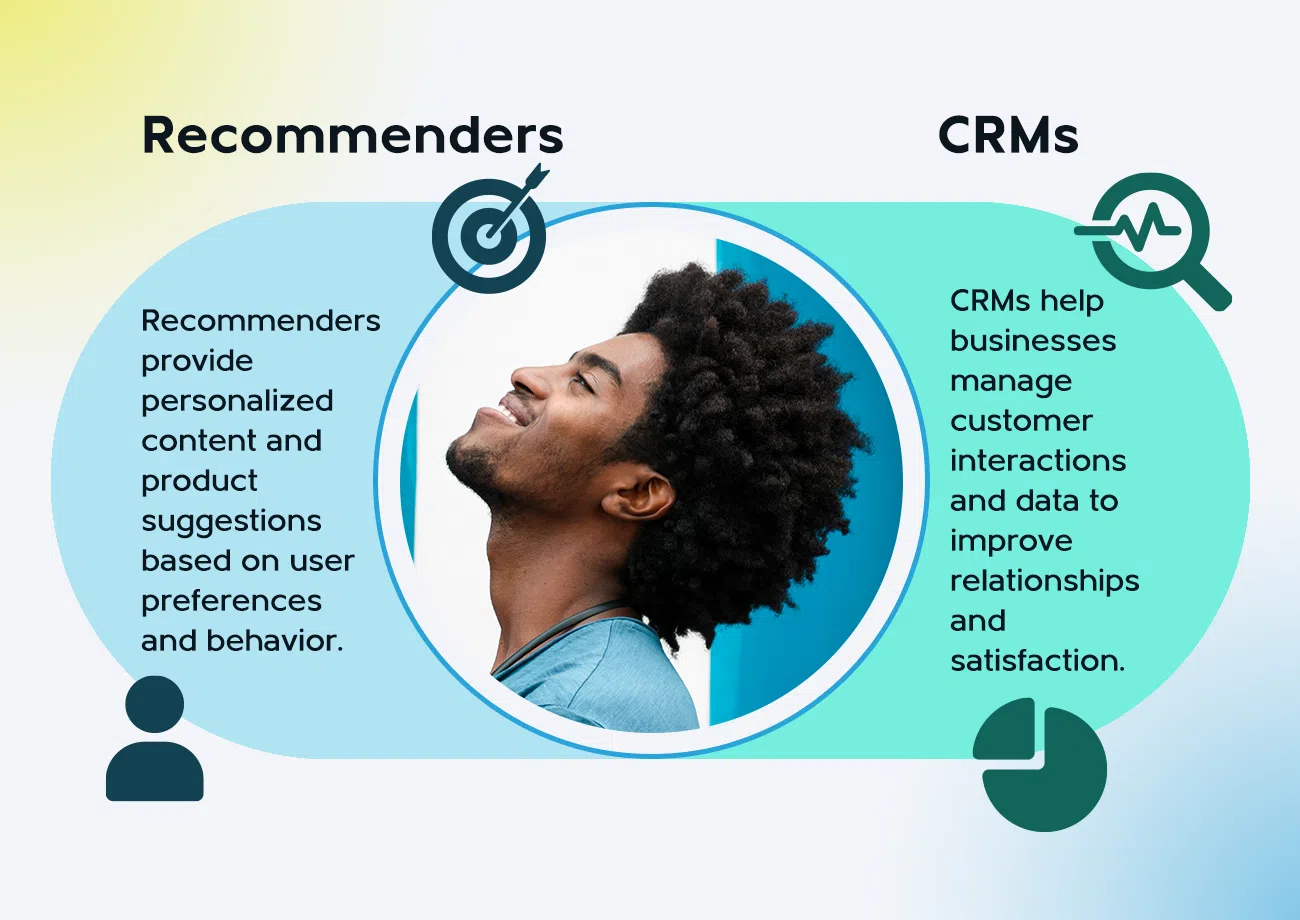How to boost online sales this holiday season with a personalized shopping experience
The holiday season is the most crucial period for retailers. Besides high sales volume, it is also an opportunity to…
Read more08. 08. 2024.

If you’re actively trying to improve your marketing efforts and improve the way your customers interact with your brand, you’ve come to the right place!
In this blog post, we’ll discuss two big concepts — recommenders and CRMs. Let’s remind ourselves of what these can do:
But what happens when we combine the two? How can one help the other? And more importantly, how can combining recommenders and CRMs help you and your business?
Let’s see!
Table of Contents
Let us remind you that a Customer Relationship Management (CRM) system is a tool that helps you and your business better manage both current and future customers.
CRMs can provide you with a comprehensive strategy for identifying potential new clients and keeping existing ones by gathering and analyzing information about their behavior and needs.
Recommenders fit into what CRMs do by improving their ability to predict and meet customer needs.
While CRMs collect and analyze customer data to manage relationships and improve satisfaction, recommenders use this data to provide personalized suggestions for products or services.
When there is enough data, integrating recommenders and CRMs can help you:
Combining recommenders and CRMs is all about personalization — targeting the right customers with the right recommendations at the right time.
But let’s see what else you can expect if you combine recommenders and CRMs.

But what are the good sides of combining recommenders and CRMs? It’s not easy to choose the right recommender for your business, but once you get it right, other things fall into place as well.
Now, when we’re talking about recommenders and CRMs, there are several benefits we would like to point out:
Make sure to read on as we discuss each benefit in detail.
One of the most significant benefits of combining recommenders and CRMs is providing a personalized customer experience.
To do that and deliver recommendations that meet individual needs, recommenders analyze customer data, such as:
According to a study by Epsilon, 80% of consumers are more likely to make a purchase when brands and companies offer personalized experiences.
With personalization, it’s important to make your customers feel valued and understood. Only then can trust come.
Another key benefit of combining recommenders and CRMs is improved customer engagement.
Personalized content generated with the help of recommenders has the power to capture your customers’ interest and encourages interaction.
One great example of personalized content might be calls-to action. For instance, HubSpot found that personalized calls-to-action perform 202% better than generic ones.
Overall, when you keep providing your customers with content and recommendations that align with their preferences and needs, they are more likely to engage with your brand. This brings you one step closer to higher conversion rates and repeated purchases.
Don’t forget that whatever you do, creating a more engaging customer journey and fostering deeper connections with your consumers should always be your top priority. Improved sales will follow suit soon enough.
Cross-selling and upselling opportunities are an important part of any successful business. Moreover, a study by McKinsey found that cross-selling and upselling can increase sales by 20% and profits by 30%.
To be able to recognize these opportunities and seize them, you can rely on recommenders.
How?
They can help you suggest relevant items at the most opportune moments to your customers by:
For example, if your customer frequently buys running shoes, the recommender might suggest high-performance running socks or a premium sports watch. By presenting these suggestions at the right time — during the checkout process or in follow-up emails — you can ensure a great customer experience and maximize your present sales opportunities.
By leveraging these insights within CRMs, you can work on boosting your revenue while providing your consumers with valuable recommendations that meet their needs.
Retaining customers can be a real challenge but Bain & Company found that increasing customer retention rates by just 5% can increase profits by 25% to 95%.
This can also be achieved by combining recommenders and CRMs.
Here’s how:
By analyzing customer behavior, recommenders help you identify customers who are at high risk of churning. This includes following several parameters, such as:
Once you identify at-risk customers, you can approach them with personalized incentives or targeted promotions designed to re-engage their interest and loyalty. For example, if you realize that a customer hasn’t made a purchase in a few months, you might send them a special discount on products they previously bought to motivate them to buy from you again.
Recommenders can truly help you anticipate and address potential churn and maintain a stronger customer base.
Choosing to combine recommenders with CRMs can also help you improve your sales and marketing efforts. In fact, a McKinsey report found that data-driven marketing can lead to a 15-20% increase in marketing ROI.
This means that it might be wise to use your CRM data and the power of recommenders to create more personalized campaigns.
This how this could look like in practice:
For example, if your CRM identifies a customer segment that buys eco-friendly products quite often, you can adapt your marketing messages to highlight sustainability and green products for that segment.
However, recommenders do come with their own set of challenges. Not acknowledging or addressing them might be bad for your business in the long run.
If you’re eager to have recommenders and CRMs work smoothly together, here’s what you would like to avoid and improve.
One major challenge with recommenders is the sparsity of data.
While online webshops and streaming services might have millions of users and thousands of products, many sometimes don’t rate what they’ve purchased or viewed. This makes the recommender struggle to capture their preferences and help you with personalization.
Without this rating data, recommenders will have a hard time trying to make accurate product suggestions to similar users. This lack of information can affect the effectiveness of your recommendations and reduce customer satisfaction.
One way to overcome this is to keep encouraging your users to provide feedback. Additionally, you can also rely on alternative data points, such as browsing history and purchase patterns, to improve the accuracy of your recommendations.
Another challenge with recommenders is the cold-start problem.
This happens when new users join your system or you add new products to your offer. Since the information about new users or new products is limited, recommenders can struggle with predicting preferences of your new users or getting ratings for new items. Consequently, the recommendations also become less accurate.
To address this, you can use alternative strategies to improve the accuracy of your recommendations for new users and products:
Coming up with simple recommendations is easy and straightforward. But, as your recommendation tasks become more complex, they will need more time and resources to come up with personalized recommendations.
Simpler algorithms are faster and use fewer resources, but they might not be as accurate or relevant. To keep recommenders effective, you should find a balance between complexity and efficiency:
Consumer preferences might change over time and throughout their CRM lifecycle.
Recommenders are usually able to identify these changes, but when they don’t — recommendations may become too general and less personalized.
To solve this, you should continuously monitor and update user data to keep your recommendations accurate and relevant and your personalization efforts on point.
To maintain personalization and accuracy, recommendations should change based on the context in which users access your products or services. Factors like the time of day, day of the week, and the device used (mobile, tablet, laptop) can affect how your users choose and buy online.
Sometimes, recommenders can struggle to include these contextual factors to come up with relevant suggestions. To address this, you should design algorithms that consider these factors, especially if you want to ensure your recommendations are always timely and appropriate.
Hopefully, after reading this blog post you have a better insight into what combining recommenders and CRMs can bring you and your business. But as recommenders and CRMs continue to evolve, relying on machine learning might prove crucial for driving customer satisfaction and business growth.
While businesses are encouraged to adopt these advanced technologies, many usually come across various challenges along the way. Yet, this shouldn’t be seen as an obstacle but rather as an opportunity to look for partners who can help you pave the way to stronger customer relationships and better performance.
Don’t wait for the right people to find you, be proactive and reach out to us today. Whether you need help choosing the right recommenders or integrating them with your CRM, we’re here for you! Contact us at ai@thingsolver.com or book a free demo to learn how we can work together to optimize your customer relationship management.
The holiday season is the most crucial period for retailers. Besides high sales volume, it is also an opportunity to…
Read moreA closer look at analytics that matter You’ve trained your AI agent. It runs. It talks. It reacts. But does…
Read moreImagine having a team of top chefs, but your fridge is packed with spoiled ingredients. No matter how talented they…
Read more